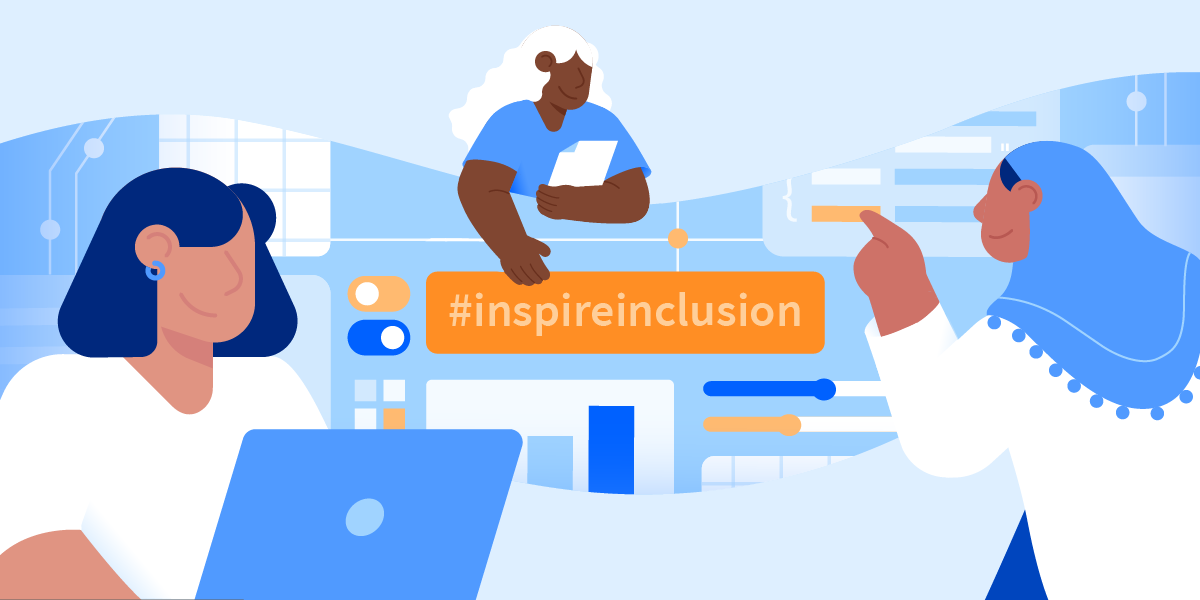Every March 8, the world unites to celebrate International Women’s Day, a day dedicated to honoring the myriad contributions of women across social, economic, cultural, and political spectrums. Recent figures from Deloitte spotlight a promising trend: between 2019 and 2022, women’s representation in the global tech workforce climbed by 6.9%, and their presence in leadership roles jumped nearly 20%.
Yet, a deeper dive reveals that despite the pioneering strides women have made across various sectors, the tech industry presents a paradox. From women holding 35% of tech leadership roles in 1984 to just 28% in 2023, the question isn’t just “why?” but “what can we do about it?”.
This International Women’s Day, StackAdapt celebrates by shining a light on the inspiring women within our organization who are not only shaping the future of tech, but are also laying down the pathways for others to follow. Through their eyes, we’ll explore the hurdles, the successes, and steps we can all take to ensure the tech world aims to #inspireinclusion while empowering women to take on more leadership roles in the future.
How has the landscape for women in tech evolved?
Initially, women were often excluded from the tech industry due to gender stereotypes and biases. I think this has evolved significantly. However, with the rise of awareness and advocacy for equal opportunities, more and more women have been able to enter and thrive in the tech industry.
- Krista Campbell, Senior Director, People & DEIB
I’ve been a software engineer for 17 years now. In that time, the number of women I’ve worked with has increased significantly to the point where I often find myself in important meetings with all women or majority women. While the amount of women in leadership positions hasn’t kept up with the growth of women in tech, the amount of women in decision making roles has increased.
- Shilpa Sequira, Engineering Manager
What significant barriers to inclusion do you believe exist today?
One notable barrier that comes to mind is companies claiming to be inclusive but failing to demonstrate inclusive practices. Companies that do not foster diverse leadership, and make an effort to bring equal opportunities, are falling behind.
- Luisana Rocha, VP of Client Services
I think unconscious bias is very pervasive. I’ve been through Unconscious Bias training, and even I, a woman in tech, have learned certain biases that are deeply embedded within all of us. It’s not a bias solely among men; it’s a hidden bias we all carry at given times. I think it’s important to raise awareness and discuss these “light bulb” moments when they strike, so we heighten our collective awareness. That’s the first step to doing better.
- Stacey Moore, Senior Vice President, Corporate IT & Operations
How do you tackle gender stereotypes in tech, overcoming personal challenges and addressing them within your teams or organization?
Patience, persistence, and resilience are key. It is about calling out inappropriate behaviours, so that collectively a group understands what is acceptable. You might have to repeat the same message several times before it lands. Don’t give up.
- Pinar Ozyetis, General Counsel
I tend to address them head on. Given my position in Talent Acquisition, I like to address historical gaps with leaders during the hiring process. I want to understand what is lacking and, where possible, get anonymized candidate data that I can use to help build a case of where I think we are lacking among certain demographic groups. From this, we can implement actionable fixes in our process.
- Kathryn Cant, Talent Operations Lead
As leaders, we have to be advocates. I embrace the idea of “send the elevator back down” and pull people up with you. We need to give women a seat at the table. Provide women who demonstrate the skills or potential stretch projects, so they gain greater exposure. And encourage women who have good ideas during meetings to speak up, so they get visibility in a forum of their peers and other leaders.
- Stacey Moore, Senior Vice President, Corporate IT & Operations
Given the trend of fewer women in leadership over time, what was an influential moment that inspired you to keep pushing on with your career growth?
Discovering I had to change the way I spoke to myself. Realizing this really influenced how to build up my self-confidence. Sharing my personal journey with other women and hearing their stories really inspired me to keep going.
- Connie Yan, Director of Platform Quality
The influential moment came while witnessing the success and tenacity of women I knew in leadership positions, both personally and professionally. This is why I have emphasized mentorship and sharing success stories. This was a motivating factor for me to continue, especially as a Black Muslim Woman.
- Amina Mohammed, Sales Director, Growth, EMEA
As a leader, how do you ensure your leadership style promotes an inclusive environment that encourages diverse voices and perspectives?
Understanding that the loudest voice in the room isn’t the most important has been key for me. I’m very cognisant of trying to give opportunities to people on my team to lead and give their input instead.
- Shilpa Sequira, Engineering Manager
I ensure inclusiveness and respect for all members of my team in Asia by taking into account everyone’s cultural and religious backgrounds. Commitment to fostering an environment where everyone’s values and beliefs are honoured speaks volumes about dedication to creating a supportive and inclusive workplace culture.
- Xinyi Peng, Client Services Manager, APAC
How important do you think male allyship is in the tech industry to advance women into leadership positions?
Extremely important. Without their support and allyship, it would be even more challenging for women to reach positions in leadership. At StackAdapt, I have been fortunate to work with multiple male leaders who recognize the value of female representation in leadership roles and make an effort for this to happen.
- Luisana Rocha, VP of Client Services
It is the difference between success and failure. I can’t overstate this. I have had strong allies who have advocated for me by calling out problematic behaviour to people in positions of power behind the scenes. To know that your leaders or peers support you in difficult situations is one of the keys to retention.
- Pinar Ozyetis, General Counsel
Male allyship is crucial. By actively seeking opportunities to mentor, sponsor, and promote women, male allies can help break down the barriers preventing women from reaching leadership positions.
- Krista Campbell, Senior Director, People & DEIB
What initiatives are essential for building a robust pipeline of women ready to take on leadership roles in the future?
Providing opportunities for hands-on experience, networking, and skill development.
- Amina Mohammed, Sales Director, Growth
Investing in education and skill-building to help foster confidence and assertiveness and making sure that women have a safe space to practice things like public speaking, negotiation, and decision-making.
- Connie Yan, Director of Platform Quality
Seeking mentorship and guidance, both internally and externally, is crucial for personal and professional development. Mentors provide valuable insights, advice, and support based on their experiences, helping women navigate challenges, make informed decisions, and achieve your goals. Mentors from within an organization offer institutional knowledge and guidance specific to the workplace. Meanwhile external mentors bring diverse perspectives and expertise from different industries or fields.
- Xinyi Peng, Client Services Manager
What message do you have for young women aspiring to tech leadership roles?
Don’t give up, especially when the going gets tough, find a support system and lean in for help. Know that the journey is going to be uncomfortable, so try new things and get comfortable with feeling uncomfortable.
- Connie Yan, Director of Platform Quality
Get a mentor, connect with others in the industry at the same level and in leadership roles, and stay in touch with them. Build that sense of community! Join groups like Monday Girl, Women Who Code, etc. and have those people you can lean on when you come across challenges.
- Kathryn Cant, Talent Operations Lead
Actively seek mentorship and look for growth opportunities in your work. Get comfortable taking risks, making mistakes and learning from it. Being risk averse, in my opinion, is the biggest barrier to a junior engineer’s growth, regardless of gender.
- Shilpa Sequira, Engineering Manager
Network with professionals in the tech industry, including peers, colleagues, and industry leaders. Join professional associations, attend conferences, and share experiences. Don’t be afraid to speak up!
- Xinyi Peng, Client Services Manager
What do you hope gender equality will look like in 10 years?
Gender equality in 10 years should mean that all individuals, regardless of gender, should have equal access to opportunities, rights, and resources. I hope that we continue to work towards achieving this and create a world where gender does not limit anyone’s potential.
- Krista Campbell, Senior Director, People & DEIB
I want the conversation around gender equality to go from “why does no one look like me?” to “hey that’s me!”.
- Connie Yan, Director of Platform Quality
For this to no longer be a hot topic as gender equality will simply become the norm.
- Luisana Rocha, VP Client Services
I envisage a future in which gender equality is not just a goal, but a reality, and the tech industry serves as a bright example of what is possible when we collaborate to create a more equitable and inclusive world.
- Amina Mohammed, Sales Director, Growth
I expect positive changes to continue over the next 10 years, but realistically it will not happen overnight. I hope we grow from 12% of women CEOs to 25%—that would be a great win. I’d like to attend a tech conference and not notice that women are vastly outnumbered. I’ll be happiest when “Women in Tech” is no longer on the agenda at corporate conferences and tech industry events and we’re just talking about “Leaders in Tech.”
- Stacey Moore, Senior Vice President, Corporate IT & Operations





